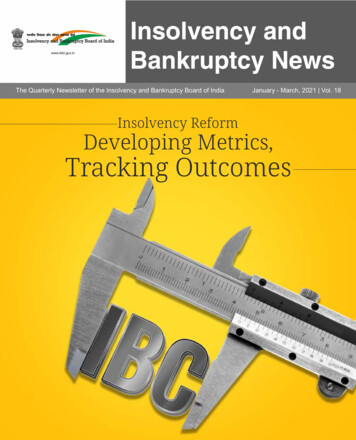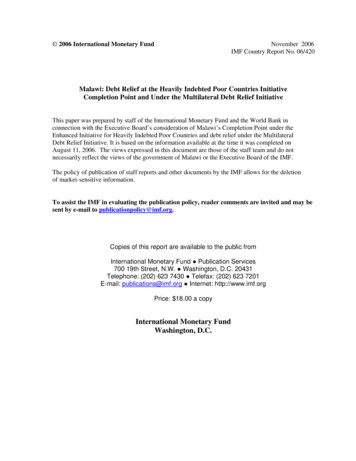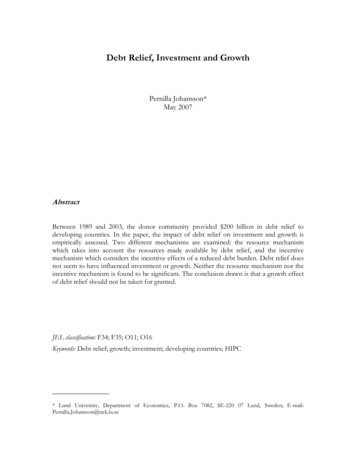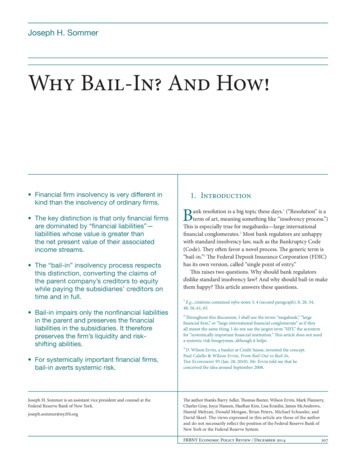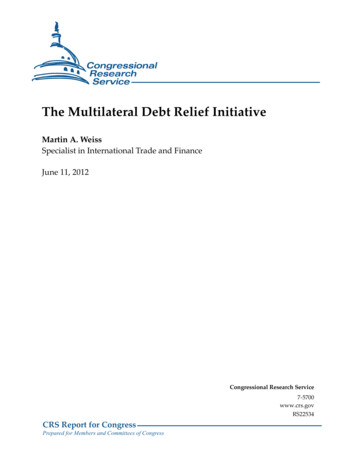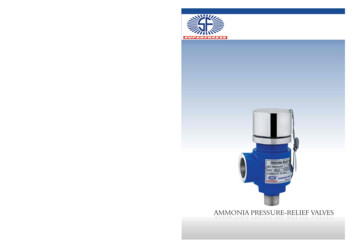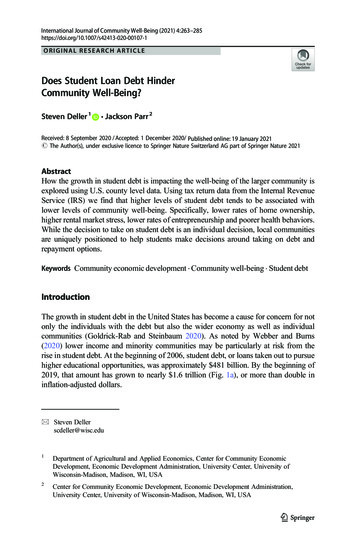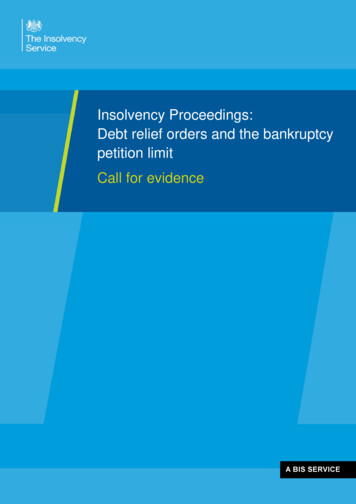
Transcription
Insolvency Proceedings:Debt relief orders and the bankruptcypetition limitCall for evidence
ForewordDebt relief orders were introduced in 2009 to help themost vulnerable people get debt relief. Unresolved debtissues can have a devastating impact on the lives ofindividuals, including on their mental health, theirrelationships and on their family.Debt relief orders give those with very few assets orincome and relatively small level of debts a simpleprocess to obtain debt relief. The debtor has supportfrom an advice agency which ensures it is the best solution for them and helps themto make the application. In the five years since debt relief orders were introduced,over 140,000 people have received debt relief.Now, it is time to review the effect debt relief orders have had on people’s lives, thatof their families, as well as those they owed money to, and to assess whether anychanges could be made to improve how they work.This call for evidence also asks whether we should make a change to the level ofdebt above which someone owed money can ask the Court to make the debtorbankrupt. Set in 1986 at 750, a person or business with an unpaid debt above thisamount is able to petition the court for an individual’s bankruptcy. I’m asking whether 750 is still an appropriate figure to be able to trigger this strongest of debt recoverytools.This call for evidence is your chance to feed in your opinion and evidence on boththe success, or otherwise, of debt relief orders, as well as on what an appropriatelevel for the creditor bankruptcy petition level is.Jo Swinson MP
Insolvency Proceedings: Debt relief orders and petitionlimits1. Introduction1.1 This document is a call for evidence for a review of the debt relief order (DRO)regime and how it can improved, and also considering the case for increasingthe creditor petition limit in bankruptcy. The call for evidence will be open until 9October.1.2 The call for evidence considers the following issues:- Whether the existing limits on assets (under 300) liabilities (lessthan 15,000) and income (surplus less than 50 pm) areappropriate and if not what should the levels be set at;The design and integrity of the system including whether thecompetent authority system of approved intermediaries to assist thedebtor apply for a DRO is working well and what the costs ofoperating it are and where they fall;Whether DROs have given people a fresh start and financialrehabilitation; andWhether the 750 limit for a creditor petitioning for bankruptcy is setat the correct level1.3 This document is aimed at: Debt advisors/debt charities Debtors Creditors and their trade bodies Academics / Think Tanks1.4 Chapter 2 covers the DRO landscape, with chapter 3 covering the case forincreasing the creditor petition limit.1.5 The Insolvency Service is also rebuilding the web-based system (project name- DRO2) used by both the Insolvency Service and the intermediaries to processDRO applications and monitor them, in order to make it more user friendly andefficient. We are consulting user groups separately on the computer system1
aspects, but if you have views we would be pleased to hear them . Anychanges that emerge from this policy review of DROs will of course feed intoany redesign of the system.1.6 All responses should be sent to the mailbox ov.uk or can be posted to:-Paul Mayo4 Abbey Orchard StreetLondonSW1P 2HTQ1 When responding can you please indicate the size of your organisation(not applicable to individuals). This will be useful for any impactassessment.Sizes of organisation are divided into:0-9 employees Micro; 10-49 Small; 50-249 Medium; 250 Large2
2. Debt relief orders2.1 DROs came into force on 6 April 2009 and apply in England and Wales. Theywere conceived to address a gap in the provision of debt relief. Debtmanagement plans and individual voluntary arrangements were possible incases where an individual had surplus income. Bankruptcy meanwhile requireda debtor to pay an upfront fee to enter, which is currently set at 705: 525deposit and 180 court fee, of which the latter can be waived in hardship cases.2.2 Moreover, bankruptcy was seen by some as a disproportionate process for lowdebt and low asset cases. In bankruptcy the trustee has a legal duty to dealwith the assets as the assets vest in (that is become the personal responsibilityof) the trustee, and is a process for realising assets and distributing theproceeds to creditors. Additionally the trustee has to consider whether toinvestigate the behaviour of the bankrupt. All of these features of bankruptcyimpose a cost which is not seen as proportionate in small sum cases.2.3 The aim of DROs was therefore to provide debt relief to those excluded fromexisting procedures – those with low levels of debt with no prospect of payingoff those debts due to low income and asset levels and without the means toenter bankruptcy. It was also designed to support the financial rehabilitation ofdebtors as its low cost provided debtors with an incentive to address their debtissues earlier.3
2.4 Box 1 sets out the key features of DROs:-BOX 1Maximum debt of 15,000Maximum assets of 300*Maximum surplus income of 50 per month 90 entry feeNo repeat DRO within 6 yearsAfter 12 months debtor emerges debt free – except for certain excluded debtsNo repayment to creditorsDuring the 12 months of the DRO – debtor unable to act as director withoutleave of the court, or access more than 500 credit without notifying the lenderof the DRO.Remains on credit history for 6 years*Excludes certain items such as a car (up to 1,000), approved pensions and basic belongings such asclothes, bedding and furniture2.5 In contrast to bankruptcy, only debts included (scheduled) in the DRO aresubject to the protection from creditors during the course of the DRO and thedebts are discharged after the DRO ends after 12 months.2.6 DROs are an administrative rather than a court based procedure.DRO system2.7 Entry to the system to the debtor is through a financial intermediary who isauthorised by one of the twelve competent authorities appointed by theSecretary of State for Business Innovation and Skills. Table 1 lists the twelvecompetent authorities and shows their number of authorised intermediaries andtheir volume of DRO applications for the most recent financial year.4
Table 1: Competent authorities, their intermediaries and the volume of theDRO applications Financial Year (“FY”) 2013/14NAME OF COMPETENT AUTHORITYNUMBER OFINTERMEDARIESAND % OF TOTALAdvice UKBaines and ErnstChristians Against PovertyCitizens Advice BureauDebt Release DirectInsolvency Practitioners AssocationInstitute of Money AdvisersNational DebtlinePayplanShelterStepChange Debt CharityThink MoneyTOTAL140 (8%)7 (0%)7 (0%)1337 (72%)1 (0%)2 (0%)287 (16%)12 (1%)12 (1%)10 (1%)31 (2%)5 (0%)1851NUMBER AND %OF DROAPPLICATIONS827 (3%)229 (1%)1097 (4%)14520 (53%)120 (0%)225 (1%)3707 (14%)1227 (4%)269 (1%)40 (0%)4962 (18%)106 (0%)273292.8 The intermediaries are highly trained debt advisors and are the principlegatekeepers to ensure that the information the debtors provides is accurate andwithin the parameters allowing entry to the DRO system. The intermediarycompletes the application, but it is the debtor’s decision whether to apply ornot.1 Intermediaries will not charge a fee for completing a DRO application.2.9 The completed application is sent to the Insolvency Service’s DRO team, whichwill process the application subject to the payment of the 90 fee by the debtor.2.10 The DRO team conducts a number of automatic checks on the data submittedby the debtor to ensure that the debtor qualifies within the parameters. TheDRO team also conducts a number of additional checks which may precludethe application, such as whether the debtor has a bankruptcy order pending,has made any preference payments or has been subject to a DRO in the pastsix years which would exclude someone from a further DRO.1If the intermediary does not think the person is eligible for a DRO they are able to indicate their disagreementwithin the DRO Web App5
2.11 Separately the application is subject to an external credit check by a creditreference agency. This checks the liabilities of the debtor (although not alldebts are captured on the credit reference agency system), the identification ofthe debtor, and that they are correctly domiciled in England and Wales toqualify for a DRO.2.12 Once these checks are completed satisfactorily, the DRO can be granted.2.13 Assuming the DRO remains in place, the DRO provides a twelve month stayfrom creditor action unless a creditor gets leave of the court. After this period,the debts are discharged, although there is no formal discharge from the DROunlike in bankruptcy2. Unlike in bankruptcy, only debts included – referred to asscheduled – in the DRO are subject to its conditions.2.14 At the time of the granting of the DRO, creditors who have scheduled debts aresent a document called a ‘Creditors’ Notice’ informing them of their rights toobject to the DRO. Only creditors can object to the granting of the DRO andonly on three grounds: The making of the order The inclusion of their debt in the list of qualifying debts The details of their debt2.15 Any objection is considered by the DRO team in the Insolvency Service. If theobjection is upheld, this can lead to the revocation of the DRO.2.16 The debtor receiving a DRO is similarly sent a ‘Debtors Notice’ informing thedebtor of their obligations. The DRO is monitored during the entire time it is inexistence to check that the debtor should remain entitled to receive the debtrelief provided by the DRO. The debtor may no longer be entitled to the DROshould they receive a significant windfall – most often compensation for missold payment protection insurance, or alternatively an inheritance payment – orget a job or a promotion. This can lead to the revocation of the DRO. It is thedebtors’ responsibility to inform the DRO team of any changes or potentialchanges to their circumstances so this can be assessed.2.17 The Insolvency Service also has the power to issue a debt relief restrictionorder or receive a debt relief restriction undertaking (DRRO/DRRU) should theOfficial Receiver consider the behaviour of someone subject to a DRO to havebeen reckless or dishonest in contributing to the DRO. This includes gamblingor making misleading statements to receive a loan. The DRO would not berevoked in such circumstances, but the person would be subject to a 2-15 year2Under bankruptcy, the person is discharged from the process. This does occur in a DRO.6
restriction extending the conditions of the DRO. This includes requiringcreditors to be informed of the DRO when obtaining credit of 500 or more, andpreventing the person acting as a company director during the restrictionwithout the court’s permission.3Pension Change2.18 When first introduced DROs were criticised for treating pensions as an asset,even when the pension was of low value and not receivable for many years,with the consequence that some people who would otherwise have qualifiedfound themselves unable to apply for a DRO because they had pension rights.2.19 This was changed in April 2011 in order to allow those with HMRC approvedpension schemes to have access to a DRO. In practice this means that if thedebtor has not retired, but has a private or occupational pension fund, in mostcases the value of the pension fund will not count towards the 300 assets limit.Social Fund Change2.20 In 2012, the Government legislated to exclude social fund debt from the list ofdebts that could be included and discharged through either a DRO orbankruptcy. Social fund loans – and its successor ‘Payment on Accounts’ - wasa finite pot of money which is loaned to people in financial difficulty. Writing offthe debt would reduce the amount available to other people in difficulty, andtherefore it was decided due to social policy concerns to add social fund loansto the existing list of government debts that could not be discharged.Basic Statistics on DROs2.21 Table 2 shows the number of DRO applications, the number of orders madeand the number of applications declined each financial year since DROs beganin 2009.4 Having stabilised around 30,000 per year in 11/12 and 12/13 – theyexperienced a 12% fall in orders made in 2013/14. Orders made were 98% ofapplications submitted in FY 2013/14.3If the DRO mortarium has ended then a debtor needs to disclose the existence of a DRRO/U.4Numbers do not tally as some applications are withdrawn before they reach determination by the DRO Team.For instance the fee may not have been paid or simply because the debtor has withdrawn their application.7
Table 2: DRO applications, orders and declined casesYearApplicationsOrders 83050126876178174170131962.22 Table 3 shows the level of debt across DRO applications since inception – thelimit being 15,000. This shows that consistently around 20% of casesassessed had debts below 5,000, whilst just over 40% of individuals had debtlevels between 5,000 and 10,000, whilst just under 40% had debt levelsbetween 10,000 and 15,000.5Table 3: Levels of DebtBelow 5,0002009-102010-112011-122012-132013-143230 (18%)5453 (21%)6247 (21%)6640 (22%)5541 (21%) 5,000 10,000 10,000 15,0007511 (42%)11373 (43%)12813 (42%)12930 (42%)11377 (42%)6966 (39%)9674 (37%)11232 (37%)11062 (36%)10053 (37%)GRANDTOTAL17707265003029230632269712.23 Table 4 shows the level of assets across DRO applications since inception –the limit being 300 for qualifying assets. This shows just under 90% have 0qualifying assets.5The numbers shown are slightly above the orders made, meaning that some cases where orders were notmade have also been assessed.8
Table 4: Level of Assets 02009-102010-112011-122012-132013-14 1- 10015197 (86%)23311 (88%)26932 (89%)27512 (90%)24018 (89%) 101- 2002169 (12%)2699 (10%)2812 (9%)2602 (8%)2305 (9%) 201- 300240 (1%)363 (1%)353 (1%)297 (1%)421 (2%)Grand Total116 (1%)143 (1%)210 (1%)263 (1%)311 (1%)17722265163030730674270552.24 Table 5 gives the breakdown level of disposable income across DROapplications – the limit being 50 per month to gain entry. Around 20% ofindividuals have negative surplus income – their expenditure is greater thantheir income, whilst between 11-15% have a surplus income of between 26 50.Table 5: Level of Disposable Income 02009-102010-112011-122012-132013-143451 (19%)5295 (20%)6370 (21%)6605 (22%)5433 (20%) 0- 2511661 (66%)17901 (67%)20556 (68%)20769 (68%)18592 (69%) 26- 50 Grand Total2613 (15%)3331 (13%)3389 (11%)3303 (11%)3037 (11%)17725265273031530677270622.25 Next turn to look at DROs from the creditors’ angle.2.26 Table 6 shows the average size of a debt owed to a creditor in a DRO. This hasdeclined from around 1,400 in 2009/10 to just above 1,100 in 2013/14.Table 6: Average level of debt per creditor in a DROFY2009/102010/112011/122012/132013/14Average Debt per creditor 1,3821,2711,2041,1621,1372.27 Table 7 looks at the amount owed to creditors for the financial year 2013/14.Over 54% ( 125million) is recorded as miscellaneous. This includes debtsowed to mobile phone companies, retailers and debt recovery firms. Theproportions may not be wholly accurate as the “Miscellaneous” category maybe overstated. Of the other categories, 29.4% is owed to banks, 8.8% to utility9
companies and 5.7% to local authorities although these are likely to beunderstatements given the mis-categorisation.Table 7: Amount and proportion of debt owed to different categories ofcreditors within DROs for the FY 2013/14Sum of Estimated AmountBK - BanksBS - Building SocietiesFI - Other Financial InstitutionsGO - Government DepartmentsLA - Local AuthoritiesLD - LandlordsMI - MiscellaneousPL - Private LendersUT - Public Utility CompaniesOtherGrand TotalProportion 67,846,256 1,143,490 1,875,571 39,033 13,149,951 22,567 124,615,195 1,807,755 20,360,086 30,883 00.0%2.28 Table 8 looks at the employment status of DRO users since inception.Unemployed is the largest category at around 50%. Those employed has risenfrom 19% in 2009/2010 to 28% in 2013/14, whilst the number self-employedremains small at around 2% - 669 individuals. Meanwhile housewife/husband(including caring for dependents) and retired account for around 10% eachrespectively.Table 8: Employment status of DRO usersYearHousewife/husband EmployedOtherincl; caring 012/132013/142RetiredSelfEmployed 12,87326,9410%28%8%5%8%2%1%48%100%10
2.29 The remainder of this chapter splits the call for evidence into three parts tofocus on the questions we believe need to be assessed in evaluating thesuccess of the DRO system and what future changes may be needed. Theseare: Access to the DRO procedure Design and integrity of the DRO system Impact on financial rehabilitationAccess to the DRO procedureEntry Parameters2.30 The entry parameters have been unchanged since DROs were introduced inApril 2009.2.31 The debt limit in DROs was designed to limit the scheme to those with lowlevels of unsecured debt rather than allowing debtors to discharge ‘excessive’sums. Those with mortgaged property were excluded by the asset limit being agross value, not a net value.2.32 If you applied an inflationary change since introduction, this would lead to thefollowing levels for April 2014 shown in Table 9. For this we use two measuresof inflation - the consumer price index and the gross domestic product (GDP)deflator.62.33 The limits were first proposed in a consultation in March 2005, so the table alsolooks at inflationary changes applied from this date. It can be argued that thismore accurately reflects the impact of inflation.Table 9: Inflation adjusted limit values for April 2014Inflation AdjustmentCurrent LimitsGDP deflator (2009)CPI (2009)GDP deflator (2005)CPI (2005)6AssetLimitDebt Limit 15,000 16,200 17,100 18,100 18,900 300 325 340 360 380GDP deflator is used for measuring national income in real terms.11Disposable incomesurplus limit 50 54 57 60 63
2.34 Scotland has recently received Royal Assent (April 2014) for a Bill whichincludes a proposal for a Minimal Assets Process (MAP) which replaces theprevious Low Income Low Asset route into bankruptcy. This is a similar productto the DRO product aimed at those with low levels of debt but who are unableto pay their debts. This is due to come into effect on 1 April 2015.MAP has the following features: Debt Limit – Minimum 1,500 – Maximum 17,000 Asset Limit - 2,000 (for relevant assets - no single asset 1,000) Entry fee – 90 Discharge – Six month discharge from debts albeit with a post-bankruptcyrestriction on credit for a further six months7 after their discharge with anoption to extend this restriction for a further six months Entry restriction – Once in 10 years (compared to 5 years for bankruptcy) Income restriction – 0 disposable income or income entirely from benefits.2.35 The maximum debt limit of 17,000 came out of discussions between theAccountant in Bankruptcy and Citizens Advice (CAB) and StepChange as itrepresented the average debt level of debt advisors’ clients, with a lower figurebeing seen as excluding too many debtors from applying.2.36 Table 10 looks at the impact raising the debt limit in isolation might have on thenumber of people using bankruptcy if they were to switch to a DRO.7A person seeking 2,000 of credit is obliged to tell the creditor about the post-bankruptcy restriction. In caseswhere 1,000 credit has already been obtained there is an obligation to tell the creditor of that existing debt.12
Table 10: Estimated value of debts held in bankruptcy cases in FY 2013/14Estimated ValueRange 0 - 15000 15001 - 16000 16001 - 17000 17001 - 18000 18001 - 19000 19001 - 20000 20001 - 22500 22501 - 25000 25001 - 27500 27501 - 30000 30001 BlankGRAND TOTALNumber in rangeProportion (nonblank 787%1%2%2%2%2%5%4%4%3%69%100%2.37 This shows that of the 23,529 bankruptcy cases in which we had data on thelevel of debt8, 1,534 could qualify for the DRO route based solely on the level ofdebt (but they might of course not meet the other criteria). Beyond the 15,000debt level and up to 30,000 the table then breaks down the additional numberof cases in each debt range. If the ceiling was raised to 20,000 an additional9% of bankruptcies would qualify for a DRO on this basis; 25,000 anadditional 18% of bankruptcies; and 30,000 would lead to 25% qualifying.2.38 A similar exercise has been carried out for the asset limit:8There were 23,578 bankruptcies in the FY 2013/14. 49 of these did not show the level of debt.13
Table 11: Estimated levels of assets held in bankruptcy cases FY 2013/14AssetValue 0-300 301-500 501-1000 1001-1500 1501-2000 2001-2500 2501-3000 3001-3500 3501-4000 4001-4500 4501-5000 5001 BlankTotalNumber in rangeProportion in range (ofthose entering a 357854%7%16%5%4%2%2%1%1%1%1%8%2.39 Ignoring the blank entries where no asset record was entered for the debtor,54% of bankruptcy cases in FY 2013/14 had an asset value within the DROrange of 0- 300. Increasing the asset limit to 2,000 would add a further 31%of bankruptcies (if they met the other criteria).2.40 Finally we have combined the asset and debtor data in bankruptcy to considerthe upper bounds of how many cases could be included if you changed thelimits simultaneously.99We have not combined with the surplus income data because the vast majority of cases are missing a surplusincome value.14
Table 12: Number of bankruptcy cases FY 2013/14 below both a debt andasset limit (but not necessarily meeting the income test for a DRO)ChangeCurrent LimitsGDP deflator(2009)CPI (2009)GDP deflator(2005)CPI (2005)EstimatedDebts 15,000 16,200AssetsNumber of casesNumber of% of cases(17,929 casescases (Ratioed(out of 17,929show both anto 23,578cases)asset debt)bankruptcies) 3004803%6224%7754% 17,100 325 340 18,100 3609325% 18,900 20,000 25,000 30,000 380 500 1,000 61,3911,7453,5845,3992.41 Table 12 looks at various permutations – including the impact of changing thelimits in line with the two inflation measures. We have 17,929 bankruptcy caseswhere values for both the asset and debt levels have been recorded. The fourthcolumn shows the number of cases out of these valid cases falling below thevarious limit, whilst the 5th column shows these as a percentage of the validcases. For example, 480 cases representing 3% of the 17,929 cases, inbankruptcy, sit below the current DRO limit of 15,000 debt and 300 eligibleassets. The final column shows how many cases this implies for the full 23,578bankruptcy cases from 2013/14 and assumes missing data matches the patternof data we have collected.10 This is provided to give a real indication of theactual effect of any change.Q2What level do you think the maximum debt amount should be set to andwhy?Q3Do you think there should be a minimum limit of debts?Q4What level do you think the maximum asset amount should be set at andwhy?2.42 Next we turn to look at the maximum level of surplus income which is currentlyset at 50 per month for DROs. Where the debtor is not subject to an IncomesPayment Order/Income Payments Agreement, surplus income data is not10This is thought to be a reasonable assumption.15
routinely collected for bankruptcy cases, and hence we have data on only 1,500of the total bankruptcy cases.2.43 If we assume that the missing cases are equally distributed in line with thecases for which we have surplus income data, 25% of bankruptcy cases lastyear fitted within the 50 maximum limit under a DRO.Table 13: Level of monthly surplus income in bankruptcy cases FY 2013/14Proportion(non blankcases)Cases 0-50 51-100 101-150 151-200 200 BlanksGRAND TOTAL388321219143463220442357825%21%14%9%30%2.44 Since 2004, the Insolvency Service has used the Living Costs and Food Surveyfor calculating surplus income. This survey is produced by the Office forNational for Statistics and sets out reasonable expenditure for differenthousehold sizes and types. Meanwhile two other calculators are exclusivelyused within the debt management and personal insolvency industry: theCommon Financial Statement (CFS); and StepChange’s debt remedycalculator. A consultation is ongoing to produce a Common Income andExpenditure Calculator to use as an industry standard.2.45 The case for making an upward revision to the DRO surplus income level isarguably weaker than other possible changes to the limits. Under bankruptcy,an Income Payments Order will be put in place taking the whole surplus incomeif a bankrupt has a surplus income of more than 20 per month, subject to anallowance for emergencies and contingencies of 10 a month for each familymember. Therefore given that DRO users will potentially get to keep moresurplus income than bankruptcy, the case for increasing the limit to make thedisparity larger still is weaker.Q5What level do you think the surplus income amount should be set at andwhy?For Q2-Q5 about the limits in addition to your views any case studyevidence would be very useful.2.46 In addition to any switching from bankruptcy that may occur if any of theselimits are raised, there may be additional people who are unable to currently16
afford the entry fee for bankruptcy ( 705) who would then be able to qualify fora DRO.Cost of DROs2.47 The cost of the DRO is 90, 80 of which covers the Insolvency Service’s costsfor administrating the scheme with 10 going to the Competent Authority. Thecharging by the Insolvency Service is on a cost recovery basis.2.48 The payment of 10 per DRO application to the competent authorities is apayment to defray against their costs and expenses, for example training ofintermediaries through a course provided by the Money Advice Trust. Thispayment is not meant to cover all costs however, because it was recognised atthe time DROs were introduced, that DROs had the potential to save debtadvisors significant time in the work they undertook on debtors’ behalf.2.49 A DRO drew a line in the sand preventing creditor action, and meant that debtadvisors did not need to negotiate any repayment or defray any action onbehalf of debtors with their creditors. In addition, it also removes the timedevoted to assisting debtors to apply for grants in order to be able to petition forbankruptcy and any queries arising out of any subsequent bankruptcyproceedings.2.50 The current cost of DROs is the same as the 90 fee the new Minimal AssetProcess is expected to charge for entry in Scotland.Q6Do you think additional costs of the competent authorities should becovered by the application fee? If so, how much and why?Payment system2.51 Debtors are able to pay the 90 fee either through using Payzone – a paymentsacceptance network available in many local shops – or through payment at thePost Office. In addition payment can also be made using a charity cheque. Inaddition to being able to pay the 90 fee as a one-off payment, the fee can alsobe paid in 5 per week instalments. We believe there may be some instanceswhere payment via either Payzone or the Post Office may not begeographically convenient.Q7Do existing payment systems provide sufficient coverage to enabledebtors to pay the fee? If not, what other payment systems should beadded?Restriction on entering the DRO process2.52 A debtor is able to obtain a DRO once every six years – a period that was partlychosen because it matched the time period that entries remain on the credit17
reference agency registers. As part of the original DRO consultation, anadditional barrier of limiting DROs to two per individual also attracted somesupport, although it was rejected on the grounds that having two separate limitson access (six years and only two applications) would make the checkingsystem unnecessarily complicated and would add to costs.2.53 Eighteen DROs have been rejected since the scheme’s inception either atapplication stage or through a subsequent revocation on the basis of theperson having had a previous DRO.2.54 As reported previously, Scotland’s Minimal Asset Process restricts access toonce every ten years. Meanwhile entry to the New Zealand No AssetsProcedure is a once only entry scheme, which is also unavailable to anyonewho has previously been bankrupt.Q8Do you consider the six year restriction is appropriate? If not, pleaseprovide reasoning for an alternative.Design and integrity of the DRO systemThe Competent Authority/Intermediary Model2.55 The model in operation was chosen for a number of reasons: The intermediaries are experienced debt advisers who are effective atextracting and interrogating the information provided by debtors, andknowing when a DRO is the most appropriate solution. This ability tointerrogate the information was seen as an important safeguard forcreditors. Some applicants could have low levels of numeracy and literacy and theintermediary either through face to face or telephone conversation, couldhelp ensure these people could access the system. Intermediaries’ filling out the forms on behalf of debtors helps reduce thecost to debtors of wasted applications where they were not suitablecandidates. The DRO system is electronic with the intermediary filling out andsubmitting the DRO application which is sent to the DRO Team within theInsolvency Service for pr
Debt relief orders give those with very few assets or income and relatively small level of debts a simple process to obtain debt relief. The debtor has support from an advice agency which ensures it is the best solution for them and helps them to make the application. In the five years since debt relief orders were introduced, over 140,000 .
